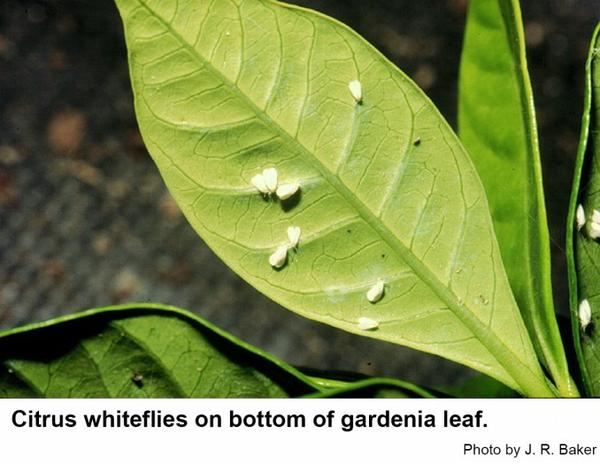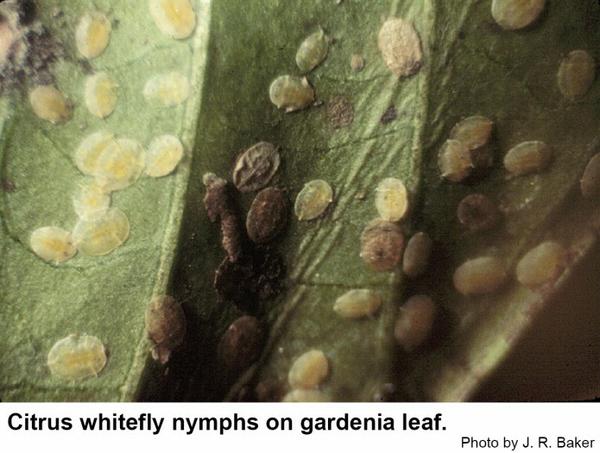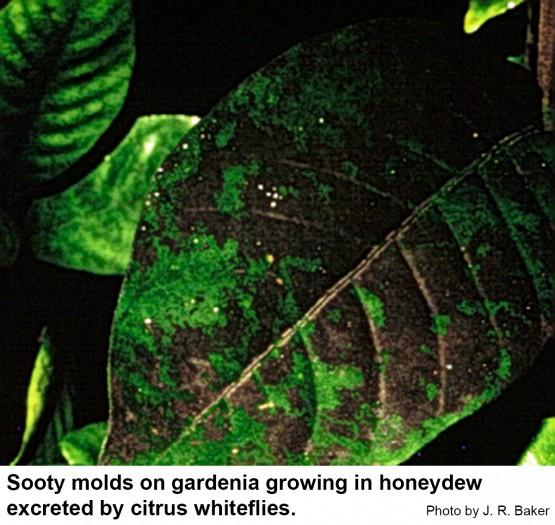General Information
Citrus whiteflies, Dialeurodes citri, are tiny, moth-like insects covered by a snow-white, waxy bloom. Each female citrus whitefly can lay up to 125 eggs by partially inserting them into the lower leaf surface. In heavy infestations, eggs may be so numerous that leaves are malformed and growth is impaired. The eggs hatch in 6 to 21 days, and tiny, pale-green crawlers move about the plant seeking a place to feed. Once they insert their long, threadlike mouthparts into the lower leaf surface, they become scale-like and no longer move about. After the first molt, legs and antennae are lost. After two additional molts, pupae form inside the last nymph skin. The adults finally emerge from T-shaped splits in the pupal skins. There are three broods each year. Summer broods require about 2 months for development; the last brood overwinters as nymphs.
Citrus Whitefly on Citrus and Gardenia
Citrus whiteflies damage their host plants directly by ovipositing and feeding. Immature citrus whiteflies suck sap from the leaves. Also, the honeydew excreted by the feeding whiteflies provides an excellent medium for the sooty mold fungus Capnodium citri. This fungus coats the leaves and stems of infested plants, making them look unhealthy, and may reduce photosynthesis. Heavily infested gardenias with substantial sooty mold may drop their leaves prematurely. The adult whiteflies themselves are often not noticed whereas the scale insect-like nymph and pupal stages may be more evident.
The citrus whitefly was introduced from Asia. Until the advent of synthetic organic pesticides, this pest caused an estimated loss of 45 to 50 percent of the citrus crops in Florida and the Gulf states. Among many other host plants, gardenias seem to be highly susceptible. The citrus whitefly has been reported on at least 38 genera of evergreen and deciduous plants. Preferred host plants include citrus, chinaberry, gardenia, privet, prickly ash, pomegranate, and Japanese persimmon.
Management
At least three species of lady beetles are known to feed on citrus whitefly crawlers and nymphs, but they are seldom numerous enough to effect real control. A tiny wasp, Encarsia lahorensis, has been introduced into several states, including NC, to help control citrus whiteflies. Lacewing larvae are also known to eat whiteflies.
Insecticides can be applied any time citrus whiteflies are noticed. Sprays should be directed to the undersides of the leaves. Horticultural oils are effective when timed correctly and with several applications. Oils do less harm to beneficial insects than pyrethroids such as Talstar, Tame, or some of the homeowner tree and shrub products that contain cyfluthrin, bifenthrin, and resmethrin (although pyrethroids, themselves, are also effective. When used as directed, pyrethroids are very toxic to insects but are not particularly hazardous to humans and pets (other than fish—avoid using pyrethroids around pools, ponds, and streams). ). Horticultural oils also have the advantage of killing and hastening the weathering away of sooty mold fungis. Some of the systemic insecticides containing imidacloprid (Merit and Bayer Advanced) or dinotefuran (Safari and GreenLight Tree and Shrub with Safari) are also effective when used properly.
Other Resources
- Insect and related Pests of Flowers and Foliage Plants. Baker, J. R., ed. 1994. NC Cooperative Extension Publication AG-136. 106 pp.
- Common name: citrus whitefly, scientific name: Dialeurodes citri (Ashmead) (Insecta: Hemiptera: Aleyrodidae). Fasulo, T, R. and H. V. Weems. 2012 (revised). Featured Creatures. Florida Department of Agriculture and Consumer Services, Division of Plant Industry.
- NC State Extension Plant Pathology Publications and Factsheets
- NC State Horticultural Science Publications
- Insect and Related Pests of Shrubs
- North Carolina Agricultural Chemicals Manual
Publication date: Jan. 31, 2013
Reviewed/Revised: Sept. 18, 2019
N.C. Cooperative Extension prohibits discrimination and harassment regardless of age, color, disability, family and marital status, gender identity, national origin, political beliefs, race, religion, sex (including pregnancy), sexual orientation and veteran status.






